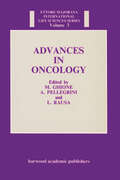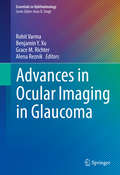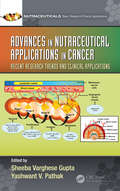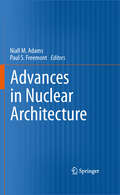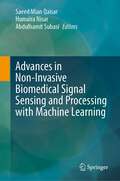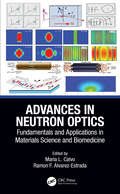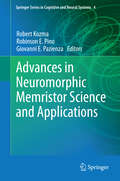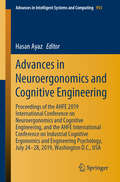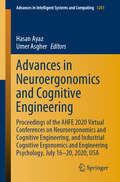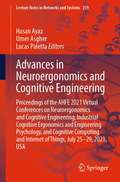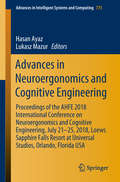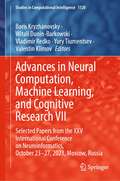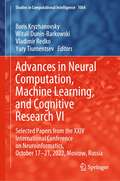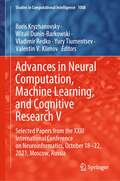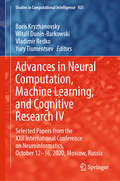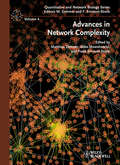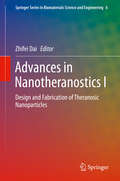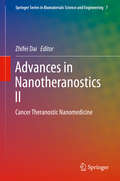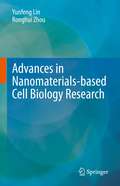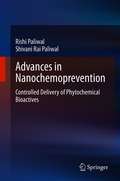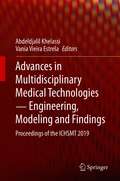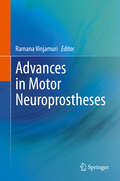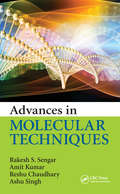- Table View
- List View
Advances in Oncology
by M. Ghione L. Rausa A. PellegriniFirst Published in 1988. This is a collection of the Proceedings of a course held at the International School of Medical Sciences Ettore Majorana Centre for Scientific Culture, Italy 5-13 September 1986.
Advances in Ocular Imaging in Glaucoma (Essentials in Ophthalmology)
by Rohit Varma Benjamin Y. Xu Grace M. Richter Alena ReznikServing as a practical guide to the ocular imaging modalities that are currently available to eye care providers for the care of glaucoma patients, this book provides information on advances in ocular imaging and their applications in the diagnosis and management of glaucoma. Each chapter introduces the imaging modality, highlight its strengths and weaknesses for clinical care, and discuss its integration into the clinical examination and decision-making process. The chapters also provide an in-depth description of the interpretation of images from each imaging modality. When appropriate, the chapters will summarize past and ongoing research and propose future research directions and clinical applications. This title will appeal to ophthalmologists and optometrists at all levels, from trainees to experienced clinicians looking to learn new and important information.
Advances in Nutrition and Cancer (Cancer Treatment and Research #159)
by Vincenzo Zappia Salvatore Panico Gian Luigi Russo Alfredo Budillon Fulvio Della RagioneThis book comprises proceedings from the Third International Conference on Advances in Nutrition and Cancer, held in Naples in May 2012. This highly multidisciplinary meeting analyzed "nutrition and cancer" from different perspectives and on the basis of distinct and up-to-date experimental approaches. Knowledge on the relation between lifestyle, diet, and cancer is explored in a number of contributions, and the role of dietary intervention in cancer patients is discussed. Issues of vital interest to the research community, such as epidemiological and experimental oncology (genetics, epigenetics, and the mechanisms of action of natural compounds in the diet), receive detailed consideration. A further key topic is the emerging molecular technologies (the "omics") that can cast light on the interplay between nutrition and human malignancies. Chapters take the form of reviews that include sections presenting expert opinions.
Advances in Nutraceutical Applications in Cancer: Recent Research Trends and Clinical Applications (Nutraceuticals)
by Sheeba Varghese Gupta Yashwant V. PathakDietary supplements and nutraceuticals such as Vitamin A and D, Omega-3 and probiotics are used as part of the cancer treatment as complimenting the main therapy. Several Nutraceuticals have shown to boost the immune responses, while emerging clinical studies and other research suggests that some plant-based agents may, indeed, impact late-stage cancer, influencing molecular processes corrupted by tumor cells to evade detection, expand clonally, and invade surrounding tissues. Advances in Nutraceutical Applications in Cancer: Recent Research Trends and Clinical Applications is an attempt to collect evidence and related clinical information of application of Nutraceuticals to be used in cancer treatment or compliment the cancer treatment. It contains 16 chapters written by experts in related field’s and covers many different aspects of the formulation and development of Nutraceuticals for cancer applications. This book covers efficacy, safety and toxicological aspects of nutraceuticals. It also addresses various novel drug delivery systems of nutraceuticals with anticancer properties, as well as nutraceuticals as supplements for cancer prevention. Features: Offers a comprehensive view of neutraceuticals’ role in cancer prevention and treatment Covers the applications and implications of neutraceuticals in prostate, colorectal, breast and gynecological cancers Discusses the principles of neutrigenomics and neutrigenetics in cancer prevention Explors the role of probiotics and micronutrients in cancer treatment and prevention Nutraceuticals can alter the gut microbiota. Gut microbiome undergoes changes during the disease status and followed by the cancer treatment. Nutraceutical’s role in proliferation and prevention of gynecological cancers, nutraceutical’s role in proliferation and prevention of prostate cancer and role of micronutrients in cancer prevention, both pros and cons, are some of the topics discussed in various chapters in this book. This book is addressed to scientists, clinicians, and students who are working in the area of Nutraceutical applications in cancer treatment.
Advances in Nuclear Architecture
by Niall M. Adams Paul S. FreemontThis book provides a snapshot of the state-of-the art in the study of mammalian cell nuclear architecture, and features a diverse range of chapters written by top researchers. A key aspect is an emphasis on precise and repeatable quantitative analysis and simulation in addition to the more familiar biological perspective. The fusion of such material frames the future of the discipline. Quantitative contributions stress reproducible and robust 3D analysis, using a variety of tools ranging from point pattern analysis to shape registration methods. Biological insights include the role of nuclear subdomains in cancer, nuclear molecular motors, and a holistic view of gene transcription.
Advances in Non-Invasive Biomedical Signal Sensing and Processing with Machine Learning
by Saeed Mian Qaisar Humaira Nisar Abdulhamit SubasiThis book presents the modern technological advancements and revolutions in the biomedical sector. Progress in the contemporary sensing, Internet of Things (IoT) and machine learning algorithms and architectures have introduced new approaches in the mobile healthcare. A continuous observation of patients with critical health situation is required. It allows monitoring of their health status during daily life activities such as during sports, walking and sleeping. It is realizable by intelligently hybridizing the modern IoT framework, wireless biomedical implants and cloud computing. Such solutions are currently under development and in testing phases by healthcare and governmental institutions, research laboratories and biomedical companies. The biomedical signals such as electrocardiogram (ECG), electroencephalogram (EEG), Electromyography (EMG), phonocardiogram (PCG), Chronic Obstructive Pulmonary (COP), Electrooculography (EoG), photoplethysmography (PPG), and image modalities such as positron emission tomography (PET), magnetic resonance imaging (MRI) and computerized tomography (CT) are non-invasively acquired, measured, and processed via the biomedical sensors and gadgets. These signals and images represent the activities and conditions of human cardiovascular, neural, vision and cerebral systems. Multi-channel sensing of these signals and images with an appropriate granularity is required for an effective monitoring and diagnosis. It renders a big volume of data and its analysis is not feasible manually. Therefore, automated healthcare systems are in the process of evolution. These systems are mainly based on biomedical signal and image acquisition and sensing, preconditioning, features extraction and classification stages. The contemporary biomedical signal sensing, preconditioning, features extraction and intelligent machine and deep learning-based classification algorithms are described. Each chapter starts with the importance, problem statement and motivation. A self-sufficient description is provided. Therefore, each chapter can be read independently. To the best of the editors’ knowledge, this book is a comprehensive compilation on advances in non-invasive biomedical signal sensing and processing with machine and deep learning. We believe that theories, algorithms, realizations, applications, approaches, and challenges, which are presented in this book will have their impact and contribution in the design and development of modern and effective healthcare systems.
Advances in Neutron Optics: Fundamentals and Applications in Materials Science and Biomedicine (Multidisciplinary and Applied Optics)
by Maria L. Calvo Ramon F. Alvarez-EstradaNeutron optics studies the interactions of a beam of slow neutrons with matter. This book updates various advances on neutron optics. There will be a focus on the very active topics of neutron imaging (NI) and neutron spin optics (NSO). The book will also present applications of neutron beams in biomedicine, such as Boron Neutron Capture Therapy (BNCT) and related techniques. Features: Discusses diffraction and interference of slow neutrons, including computational approaches Reviews neutron imaging (NI) and neutron spin optics (NSO) Treats two major sources of slow neutron beams: (1) fission reactions at nuclear reactors and (2) collisions in particle accelerators (small ones, spallation sources) of charged particle beams with targets of heavy atoms Selects subjects on fundamental quantum aspects of slow neutrons and on confined propagation and waveguiding thereof Updates slow neutron beams and BNCT
Advances in Neuromorphic Memristor Science and Applications (Springer Series in Cognitive and Neural Systems #4)
by Robinson E. Pino Robert Kozma Giovanni E. PazienzaPhysical implementation of the memristor at industrial scale sparked the interest from various disciplines, ranging from physics, nanotechnology, electrical engineering, neuroscience, to intelligent robotics. As any promising new technology, it has raised hopes and questions; it is an extremely challenging task to live up to the high expectations and to devise revolutionary and feasible future applications for memristive devices. The possibility of gathering prominent scientists in the heart of the Silicon Valley given by the 2011 International Joint Conference on Neural Networks held in San Jose, CA, has offered us the unique opportunity of organizing a series of special events on the present status and future perspectives in neuromorphic memristor science. This book presents a selection of the remarkable contributions given by the leaders of the field and it may serve as inspiration and future reference to all researchers that want to explore the extraordinary possibilities given by this revolutionary concept.
Advances in Neuroergonomics and Cognitive Engineering: Proceedings of the AHFE 2019 International Conference on Neuroergonomics and Cognitive Engineering, and the AHFE International Conference on Industrial Cognitive Ergonomics and Engineering Psychology, July 24-28, 2019, Washington D.C., USA (Advances in Intelligent Systems and Computing #953)
by Hasan AyazThis book offers a broad perspective on the field of cognitive engineering and neuroergonomics, covering emerging practices and future trends toward the harmonious integration of human operators and computer systems. It presents novel theoretical findings on mental workload and stress, activity theory, human reliability, error and risk, and neuroergonomic measures alike, together with a wealth of cutting-edge applications. Further, the book describes key advances in our understanding of cognitive processes, including mechanisms of perception, memory, reasoning, and motor response, with a special emphasis on their role in interactions between humans and other elements of computer-based systems. Based on the AHFE 2019 affiliated conference on Neuroergonomics and Cognitive Engineering, held on July 24-28, 2019, in Washington D.C., USA, it provides readers with a comprehensive overview of the current challenges in cognitive computing and factors influencing human performance.
Advances in Neuroergonomics and Cognitive Engineering: Proceedings of the AHFE 2020 Virtual Conferences on Neuroergonomics and Cognitive Engineering, and Industrial Cognitive Ergonomics and Engineering Psychology, July 16-20, 2020, USA (Advances in Intelligent Systems and Computing #1201)
by Hasan Ayaz Umer AsgherThis book offers broad overview of the field of cognitive engineering and neuroergonomics, covering emerging practices and future trends toward the harmonious integration of human operators and computer systems. It presents novel theoretical findings on mental workload and stress, activity theory, human reliability, error and risk, and a wealth of cutting-edge applications, such as strategies to make assistive technologies more user-oriented. Further, the book describes key advances in our understanding of cognitive processes, including mechanisms of perception, memory, reasoning, and motor response, with a particular focus on their role in interactions between humans and other elements of computer-based systems. Gathering the proceedings of the AHFE 2020 Virtual Conferences on Neuroergonomics and Cognitive Engineering, and Industrial Cognitive Ergonomics and Engineering Psychology, held on 16–20 July 2020, this book provides extensive and timely information for human–computer interaction researchers, human factors engineers and interaction designers, as well as decision-makers.
Advances in Neuroergonomics and Cognitive Engineering: Proceedings of the AHFE 2021 Virtual Conferences on Neuroergonomics and Cognitive Engineering, Industrial Cognitive Ergonomics and Engineering Psychology, and Cognitive Computing and Internet of Things, July 25-29, 2021, USA (Lecture Notes in Networks and Systems #259)
by Hasan Ayaz Umer Asgher Lucas PalettaThis book offers a broad overview of the field of cognitive engineering and neuroergonomics, covering emerging practices and future trends toward the harmonious integration of human operators and computational systems. It gathers both theoretical and practice-oriented studies on mental workload and stress, activity theory, human reliability, error and risk. It covers applications in various field, and corresponding strategies to make assistive technologies more user-oriented. Further, the book describes key advances in our understanding of cognitive processes, including mechanisms of perception, memory, reasoning, and motor response, with a particular focus on their role in interactions between humans and other elements of computer-based systems. Gathering the proceedings of the AHFE 2021 Conferences on Neuroergonomics and Cognitive Engineering, Industrial Cognitive Ergonomics and Engineering Psychology, and Cognitive Computing and Internet of Things, held virtually on July 25-29, 2021, from USA, this book offers extensive information and a thought-provoking guide for researchers and practitioners in cognitive engineering, neuroergonomics and their applications.
Advances in Neuroergonomics and Cognitive Engineering: Proceedings of the AHFE 2018 International Conference on Neuroergonomics and Cognitive Engineering, July 21–25, 2018, Loews Sapphire Falls Resort at Universal Studios, Orlando, Florida USA (Advances in Intelligent Systems and Computing #775)
by Hasan Ayaz Lukasz MazurThis book offers a broad perspective on the field of cognitive engineering and neuroergonomics, covering emerging practices and future trends toward the harmonious integration of human operators and computer systems. It presents novel theoretical findings on mental workload and stress, activity theory, human reliability, error and risk, and neuroergonomic measures alike, together with a wealth of cutting-edge applications. Further, the book describes key advances in our understanding of cognitive processes, including mechanisms of perception, memory, reasoning, and motor response, with a special emphasis on their role in interactions between humans and other elements of computer-based systems. Based on the AHFE 2018 affiliated conference on Neuroergonomics and Cognitive Engineering, held on July 21–25, 2018, in Orlando, Florida, USA, it provides readers with a comprehensive overview of the current challenges in cognitive computing and factors influencing human performance.
Advances in Neural Computation, Machine Learning, and Cognitive Research VII: Selected Papers from the XXV International Conference on Neuroinformatics, October 23-27, 2023, Moscow, Russia (Studies in Computational Intelligence #1120)
by Boris Kryzhanovsky Witali Dunin-Barkowski Vladimir Redko Yury Tiumentsev Valentin KlimovThis book describes new theories and applications of artificial neural networks, with a special focus on answering questions in neuroscience, biology and biophysics and cognitive research. It covers a wide range of methods and technologies, including deep neural networks, large-scale neural models, brain–computer interface, signal processing methods, as well as models of perception, studies on emotion recognition, self-organization and many more. The book includes both selected and invited papers presented at the XXV International Conference on Neuroinformatics, held on October 23-27, 2023, in Moscow, Russia.
Advances in Neural Computation, Machine Learning, and Cognitive Research VI: Selected Papers from the XXIV International Conference on Neuroinformatics, October 17-21, 2022, Moscow, Russia (Studies in Computational Intelligence #1064)
by Boris Kryzhanovsky Witali Dunin-Barkowski Vladimir Redko Yury TiumentsevThis book describes new theories and applications of artificial neural networks, with a special focus on answering questions in neuroscience, biology and biophysics and cognitive research. It covers a wide range of methods and technologies, including deep neural networks, large-scale neural models, brain–computer interface, signal processing methods, as well as models of perception, studies on emotion recognition, self-organization and many more. The book includes both selected and invited papers presented at the XXIV International Conference on Neuroinformatics, held on October 17–21, 2022, in Moscow, Russia.
Advances in Neural Computation, Machine Learning, and Cognitive Research V: Selected Papers from the XXIII International Conference on Neuroinformatics, October 18-22, 2021, Moscow, Russia (Studies in Computational Intelligence #1008)
by Boris Kryzhanovsky Witali Dunin-Barkowski Vladimir Redko Yury Tiumentsev Valentin V. KlimovThis book describes new theories and applications of artificial neural networks, with a special focus on answering questions in neuroscience, biology and biophysics and cognitive research. It covers a wide range of methods and technologies, including deep neural networks, large scale neural models, brain computer interface, signal processing methods, as well as models of perception, studies on emotion recognition, self-organization and many more. The book includes both selected and invited papers presented at the XXIII International Conference on Neuroinformatics, held on October 18-22, 2021, Moscow, Russia.
Advances in Neural Computation, Machine Learning, and Cognitive Research IV: Selected Papers from the XXII International Conference on Neuroinformatics, October 12-16, 2020, Moscow, Russia (Studies in Computational Intelligence #925)
by Boris Kryzhanovsky Witali Dunin-Barkowski Vladimir Redko Yury TiumentsevThis book describes new theories and applications of artificial neural networks, with a special focus on answering questions in neuroscience, biology and biophysics and cognitive research. It covers a wide range of methods and technologies, including deep neural networks, large scale neural models, brain computer interface, signal processing methods, as well as models of perception, studies on emotion recognition, self-organization and many more. The book includes both selected and invited papers presented at the XXII International Conference on Neuroinformatics, held on October 12-16, 2020, Moscow, Russia.
Advances in Network Complexity
by Frank Emmert-Streib Matthias Dehmer Abbe MowshowitzA well-balanced overview of mathematical approaches to complex systems ranging from applications in chemistry and ecology to basic research questions on network complexity. Matthias Dehmer, Abbe Mowshowitz, and FrankEmmert-Streib, well-known pioneers in the fi eld, have edited this volume with a view to balancing classical and modern approaches to ensure broad coverage of contemporary research problems.The book is a valuable addition to the literature and a must-have for anyone dealing with network compleaity and complexity issues.
Advances in Nanotheranostics I: Design and Fabrication of Theranosic Nanoparticles (Springer Series in Biomaterials Science and Engineering #6)
by Zhifei DaiThis book highlights the recent advances in nanotheranostics from basic research to potential applications, and discusses the modular design and engineering of multiplex nanoparticles including gold nanostructures, luminescent nanoparticles, dendrimers and liposomes. Each chapter demonstrates multifunctional nanoparticles with topics covering targeting, imaging, delivery, diagnostics, and therapy as new modalities for cancer theranostics. This comprehensive book presents expert views on the latest developments in theranostic nanomedicine. It focuses on potential theranostic applications of multifunctional nanoparticles ranging from identifying noninvasively cancer cells by molecular detection, and visualizing in vivo drug delivery by means of contrast enhanced imaging, to destroying cancer cell s with minimal side effects via selective accumulation at tumor sites, and real-time monitoring therapeutic effectiveness. It also presents an interdisciplinary survey of nanotheranostics and as such is a valuable resource for researchers and students in related fields. Zhifei Dai is a Professor at the Department of Biomedical Engineering, College of Engineering, Peking University, China.
Advances in Nanotheranostics I: Cancer Theranostic Nanomedicine (Springer Series in Biomaterials Science and Engineering #7)
by Zhifei DaiThis book highlights the recent advances in nanotheranostics from basic research to potential applications, and discusses the modular design and engineering of multiplex nanoparticles including gold nanostructures, luminescent nanoparticles, dendrimers and liposomes. Each chapter demonstrates multifunctional nanoparticles with topics covering targeting, imaging, delivery, diagnostics, and therapy as new modalities for cancer theranostics. This comprehensive book presents expert views on the latest developments in theranostic nanomedicine. It focuses on potential theranostic applications of multifunctional nanoparticles ranging from identifying noninvasively cancer cells by molecular detection, and visualizing in vivo drug delivery by means of contrast enhanced imaging, to destroying cancer cell s with minimal side effects via selective accumulation at tumor sites, and real-time monitoring therapeutic effectiveness. It also presents an interdisciplinary survey of nanotheranostics and as such is a valuable resource for researchers and students in related fields. Zhifei Dai is a Professor at the Department of Biomedical Engineering, College of Engineering, Peking University, China.
Advances in Nanomaterials-based Cell Biology Research
by Yunfeng Lin Ronghui ZhouThis book aims to comprehensively summarize the current research status of nanomaterials and cell biology. It highlights the biological effects and biomedical applications of nanomaterials for specific diseases, bone tissue engineering, and skeletal muscle regeneration. It also provides the details of the biomedical applications of nucleic acid nanomaterials in drug delivery carriers, antimicrobial therapy, vaccine, and neurodegenerative diseases. Therefore, this book renders the audience a better understanding of nanomaterials along with the diverse applications in the cell biology field from recent works to perspectives.
Advances in Nanochemoprevention: Controlled Delivery of Phytochemical Bioactives
by Rishi Paliwal Shivani Rai PaliwalThis book discusses the recent progress and advances in nanochemoprevention. Chemoprevention utilizes natural dietary compounds and has regained interest due to larger safety window and proven efficacy of such molecules in cancer treatments. Nanotechnology has revolutionized drug delivery through passive as well as active targeting. This book provides a comprehensive overview of phytochemical bioactives that are used in chemoprevention. It gives a comprehensive overview of the variety of natural molecules and types of nanoparticles as well as mechanistic aspects of their superior efficacy over plain drug molecules. The book concludes with summarizing the progress of pre-clinical results of developed formulations for cancer treatment using nano-chemoprevention.
Advances in Nail Disease and Management (Updates in Clinical Dermatology)
by Robert L. BaranThis book serves as a concise text on nail diseases and disorders, offering the most up to date information available from internationally recognized speakers and authors. This comprehensive guide examines a multitude of nail disease types manifestations, treatments, and complications. Chapters delve into specific disorders such as yellow nail syndrome, psoriasis, lichen planus, and brittle nails. Notable treatments covered include advances in MRI, anti-neoplastic drugs and ultrasound imaging. The book also features discussions on unique topics, such as the convergence of orthopedics and onychology in nail disease treatment, as well as treatment complications faced by distinct demographics. Going beyond basics and diving right into the heart of various diseases and disorders, Advances in Nail Disease and Management will serve to aid experienced dermatologists looking for advanced expertise information.
Advances in Multidisciplinary Medical Technologies ─ Engineering, Modeling and Findings: Proceedings of the ICHSMT 2019
by Vania Vieira Estrela Abdeldjalil KhelassiThis book collects the proceedings of the International Congress on Health Sciences and Medical Technologies (ICHSMT), held in Tlemcen, Algeria, from December 5 to 7, 2019. The proceedings present a forum for the latest projects and research in scientific and technological development with an emphasis on smart healthcare system design and future technologies. ICHSMT brings together researchers, students, and professionals from the healthcare, corporate, and academic sectors. It includes a far-reaching program supported by a variety of technical tracks that seek to promote medical technologies and innovation at a nationwide level.
Advances in Motor Neuroprostheses
by Ramana VinjamuriThis book provides a comprehensive review of recent developments in the field of motor neuroprosthetics and brain-machine interfaces. Chapters in this book are provided by leading experts in the field and include topics such as the design and control of multidimensional prosthetics and exoskeletons, deep brain stimulation, functional electrical stimulation, deep learning for brain machine interfaces, biofeedback, and cognitive intent for adaptation of motor prostheses. This book is a great resource for undergraduate and graduate students, researchers, engineers from related disciplines, entrepreneurs, and anyone interested in the latest progress in the field of motor neuroprostheses.
Advances in Molecular Techniques
by Amit Kumar Ashu Singh Rakesh S. Sengar Reshu ChaudharyMolecular genetics aims to comprehend biological activity at the gene sub-level. Scientists from different areas of research and applied science can use the standard techniques optimized by molecular biologists.This book serves as a guide that introduces classic molecular biology techniques and advances in molecular and genetic engineering.
